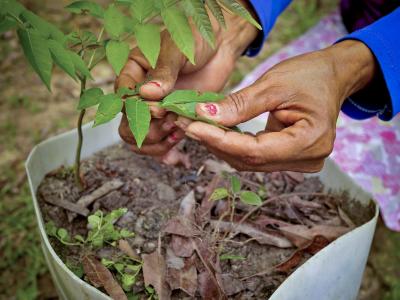Monitoring and evaluating climate change adaptation in the Colombia’s agricultural sector

1 November 2018, Colombia - Colombia’s Ministry of Agriculture and Rural Development (MADR in Spanish) hosted a seminar in Bogotá, Colombia, October 3 and 4 to address the monitoring and evaluation of climate change adaptation in the agricultural sector. The seminar was hosted through the Integrating Agriculture in National Adaptation Plans Programme (NAP-Ag), a multi-country support programme led by the UNDP and FAO and financed by the Government of Germany (BMU).
By conceptualizing a monitoring and evaluation (M&E) system for adaptation in the agricultural sector, the seminar advances the construction of national M&E reference frameworks for adaptation at the sectoral level. This M&E system complies with national information strategies for climate change management and is led by the IDEAM, the technical secretariat of the technical and scientific information committee on climate change under the National Climate Change System (SISCLIMA).
The seminar responds to the growing need to monitor adaptation processes and results at the national level and communicate them globally under different international conventions and frameworks. For example, at the Third National Climate Change Convention (TCNCC), Colombia presented a climate change risk report to the United Nations Framework Convention on Climate Change (UNFCCC). The report included some advances in adaptation initiatives and the results of the country's climate change vulnerability analysis.
In all, 30 participants representing 16 institutions took part in the seminar, including entities from the business sector, research institutes, universities, the Institute of Hydrology, Meteorology, and Environmental Studies (IDEAM), the Ministries of Agriculture and Rural Development (MADR), the Ministry of Environment and Sustainable Development (MADS), the National Department of Planning (DNP), and the National Department of Statistics (DANE).
The seminar provided techniques and methods to initiate the construction of an M&E framework for the agricultural sector. It also identified and stipulated an initial set of relevant indicators to measure the sector's vulnerability in terms of water resources, biodiversity and food safety.
A participatory methodology was applied to educate and spark assertive and transformative conversations among participants. This included referencing the performance framework of Kenya and citing examples of M&E systems adopted at the national level by Australia, France, Germany, Morocco, Mozambique, Nepal, Norway, the Philippines, South Africa and the United Kingdom. Additionally, UNDP shared lessons learned from a new GCF-financed climate-resilience project in La Mojana, while the CCAFS described climate-adapted, sustainable agricultural practices in the Popayán-Cauca municipality.
One of the most impactful conclusions was the participants' acknowledgment of the connections between sustainable development and climate change agendas, which they expressed through the need to accelerate the reduction of inequality and rural poverty so that the agricultural sector can begin to address the impacts of climate change.
Most of the discussion focused on identifying the indicators that should be taken into account to assess the agricultural sector's vulnerability to climate change. Participants selected 33 of 45 climate change vulnerability indicators listed in the TCNCC analysis and identified 41 new indicators that could be included in the sectoral vulnerability analysis, including a data source for designing an M&E system for the Comprehensive Climate Change Management Plan in the Agricultural Sector.
Next steps for continued support of the Colombian government are also outlined in the vulnerability and risk analysis, a decision-making tool that connects science with public policy in building a national strategy for climate change management.
Links
- Scaling up Climate Resilient Water Management Practices for Vulnerable Communities in La Mojana, Colombia
- Climate Change Adaptation in the Cundinamarca Department of Colombia (TACC)